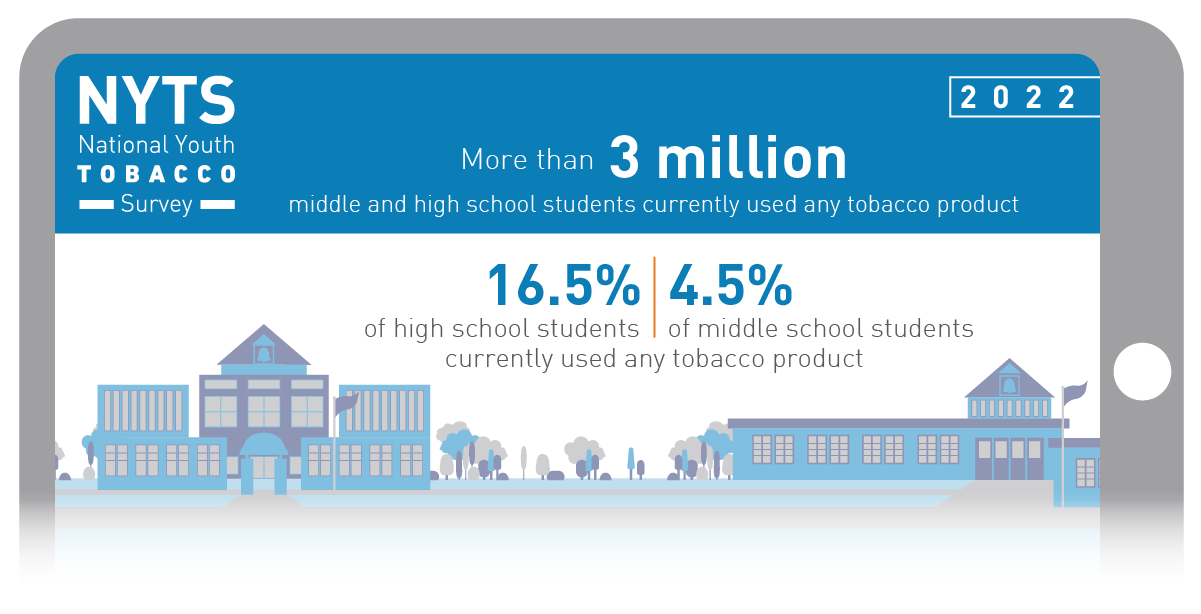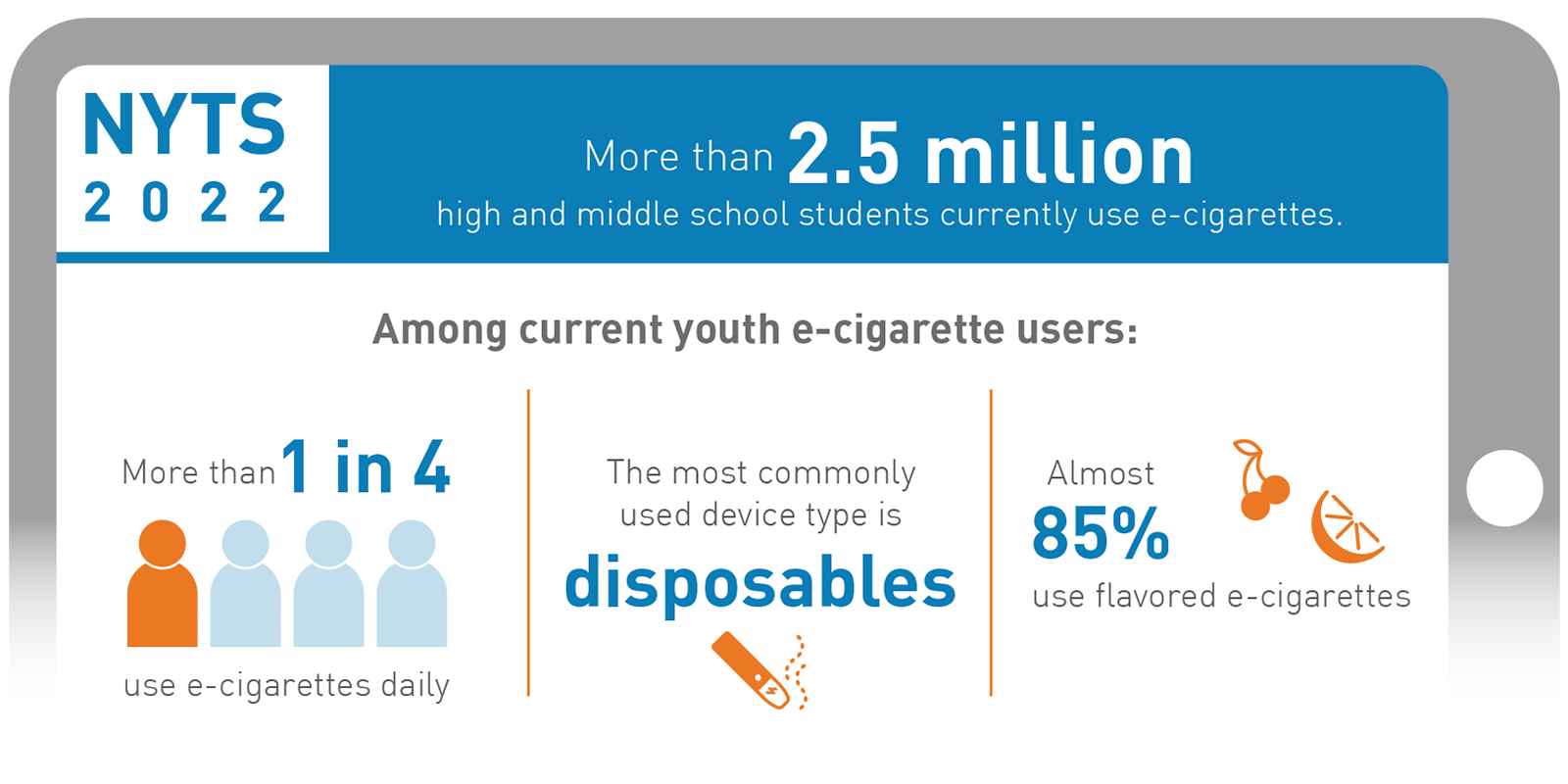Results from the Annual National Youth Tobacco Survey
On this page:
- 2022 Findings on Youth Tobacco Use
- 2022 Findings on Youth E-Cigarette Use
- Public Education Campaigns
- Goals of NYTS
2022 Findings on Youth Tobacco Use
In November 2022, FDA and Centers for Disease Control and Prevention (CDC) released federal data from the 2022 National Youth Tobacco Survey (NYTS) on youth tobacco use in the Morbidity and Mortality Weekly Report: “Tobacco Product Use among Middle and High School Students — United States, 2022.” Findings show that in 2022, more than 1 in 10 middle and high school students (3.08 million) had used a tobacco product during the past 30 days - including 16.5% of high school and 4.5% of middle school students.
Current Use
- 11.3% (3.08 million) of middle and high school students reported current use (past 30 days) of any tobacco product
- Approximately 3.7% (1.00 million) of all students reported currently smoking any combustible tobacco product
- 3.5% (960,000) reported current use of multiple (≥2) tobacco products
Most Commonly Used Types of Devices
- E-cigarettes (9.4%)
- Cigars (1.9%)
- Cigarettes (1.6%)
- Smokeless (1.3%)
- Hookahs (1.1%)
- Nicotine Pouches (1.1%)
- Heated Tobacco Products (1.0%)
- Pipe Tobacco (0.6%)
Demographics and Social Determinants of Health
Current Use (past 30 days) of Any Tobacco Product (middle and high school):
- 13.5% of non-Hispanic American Indian or Alaska Native (AI/AN) students
- 16.0% of those identifying as lesbian, gay or bisexual
- 16.6% of those identifying as transgender
- 18.3% of those reporting severe symptoms of psychological distress
- 12.5% of those with low family affluence
- 27.2% of those with low academic achievements (mostly Fs)
Methodology
The 2022 data was collected between January and May of 2022, using an online survey among U.S. middle school (grades 6-8) and high school (grades 9-12) students. The use of an online survey allows all eligible students to participate in a classroom or at home during a designated class period as part of a class activity, however most students completed the survey in a classroom setting. Prior to 2021, the survey was solely conducted in a classroom setting. Due to changes in methodology, including differences in survey administration and data collection procedures in recent years due to the COVID-19 pandemic, the ability to compare estimates from 2022 with those from prior NYTS waves is limited.
2022 Findings on Youth E-Cigarette Use
In October 2022, FDA and Centers for Disease Control and Prevention (CDC) released federal data from the 2022 National Youth Tobacco Survey (NYTS) on e-cigarette use among U.S. youth in the Morbidity & Mortality Weekly Report “Notes from the Field: E-cigarette Use Among Middle and High School Students — United States, 2022.” E-cigarette use among youth remains a top concern for the FDA. In 2022, about 1 in 10 or more than 2.5 million U.S. middle and high school students currently used e-cigarettes (past 30-day).
Current Use
- 14.1% (2.14 million) of high school students and 3.3% (380,000) of middle school students reported current e-cigarette use.
Flavored E-Cigarette Use
- Overwhelmingly, current users (nearly 85%) used flavored e-cigarettes, with fruit flavors being the most popular, followed by candy, desserts, or other sweets.
Frequency of Use
- More than a quarter (27.6%) of current youth e-cigarette users use an e-cigarette product every day.
- More than 4 in 10 youth e-cigarette users report using e-cigarettes at least 20 of the last 30 days.
Type of Device
- The most commonly used device among current users was disposables (55.3%), followed by prefilled/refillable pods or cartridges (25.2%).
Commonly Used Brands
- Current users reported their usual brands as: Puff Bar (14.5%), Vuse (12.5%), Hyde (5.5%) and SMOK (4%).
Methodology
The 2022 data was collected between January and May of 2022, using an online survey among U.S. middle school (grades 6-8) and high school (grades 9-12) students. The use of an online survey allows all eligible students to participate in a classroom or at home during a designated class period as part of a class activity, however most students completed the survey in a classroom setting. Prior to 2021, the survey was solely conducted in a classroom setting. Due to changes in methodology, including differences in survey administration and data collection procedures in recent years due to the COVID-19 pandemic, the ability to compare estimates from 2022 with those from prior NYTS waves is limited.
Public Education Campaigns
FDA conducts several public education campaigns aimed at young audiences to prevent youth from tobacco initiation and use. FDA’s longest-running campaign, “The Real Cost,” educates teens on the health consequences of smoking cigarettes and in recent years has prioritized e-cigarette prevention messaging.
In the 2021 NYTS, 75.2% of middle and high school students reported having seen or heard any antitobacco public education campaign ad within the past year. An estimated 15.8 million (60.9%) students reported recognizing the FDA’s “The Real Cost” campaign ad: by school level, almost two-thirds (65.8%) of high school students and more than half (54.8%) of middle school students reported recognizing “The Real Cost” campaign ad.
FDA Tobacco
Education Resource Library
Embed FDA tobacco content on your website for free. Through the FDA Tobacco Education Resource Library, when content is updated on our site, it will automatically update on your site as well.
However, public health education campaigns are not the only messaging about tobacco products that youth receive and notice.
They might see advertisements for tobacco products while engaging in common activities – such as going to a convenience store, supermarket, or gas station; using the Internet; watching television or streaming services or going to the movies; or reading newspapers or magazines. In the 2021 NYTS, among youth who reported engaging in those common activities, 75.7% reported exposure to marketing or advertising for any tobacco product.
Among students who reported using social media, 73.5% had ever seen e-cigarette–related content.
Goals of NYTS
FDA is committed to a science-based approach that addresses public health issues associated with tobacco use. We collaborate with CDC on this nationally representative survey of middle and high school students that focuses exclusively on tobacco use behaviors and associated factors.
NYTS was designed to provide national data on long-term, intermediate, and short-term indicators key to the design, implementation, and evaluation of comprehensive tobacco prevention and control programs.
For a deeper look at the agencies’ collaboration on the study over the years, see CDC’s “Historical NYTS Data and Documentation.”



